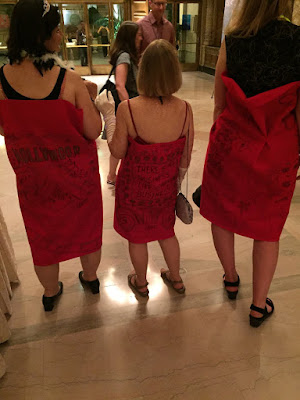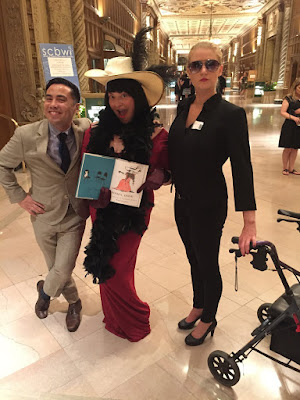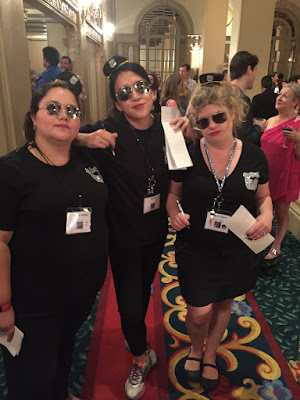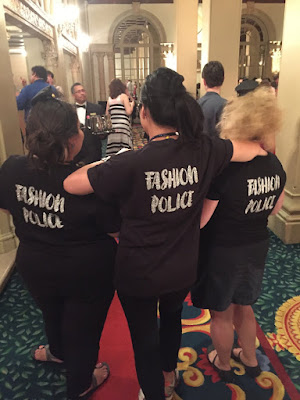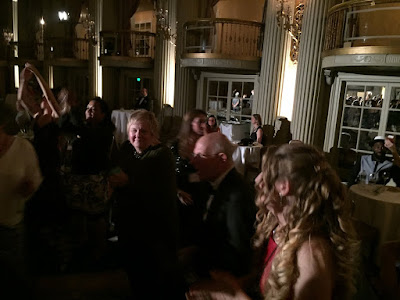new posts in all blogs
Viewing: Blog Posts Tagged with: #LA16SCBWI, Most Recent at Top [Help]
Results 1 - 25 of 47
How to use this Page
You are viewing the most recent posts tagged with the words: #LA16SCBWI in the JacketFlap blog reader. What is a tag? Think of a tag as a keyword or category label. Tags can both help you find posts on JacketFlap.com as well as provide an easy way for you to "remember" and classify posts for later recall. Try adding a tag yourself by clicking "Add a tag" below a post's header. Scroll down through the list of Recent Posts in the left column and click on a post title that sounds interesting. You can view all posts from a specific blog by clicking the Blog name in the right column, or you can click a 'More Posts from this Blog' link in any individual post.
 |
| hard at work |
From all of us on SCBWI Team Blog, thanks for joining us for the 2016 SCBWI Summer Conference.
We hope to see you in New York City, February 10-12, 2017, for #NY17SCBWI. The 2017 SCBWI Winter Conference will include full-day intensives for both writers & illustrators, a juried portfolio showcase with a grand prize, workshops, keynotes, the opportunity to network with top editors, art directors, agents and publishers, and so much more!
|
From left to right, your SCBWI Team Blog: Don Tate, Jolie Stekly, Martha Brockenbrough, Jaime Temairik, and Lee Wind |
Thanks to Kim Turrisi and Linda Sue Park for the pictures!
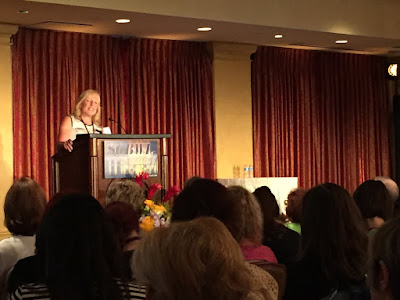 |
| Ellen Hopkins |
Ellen Hopkins is a poet and the award-winning author of eleven New York Times best-selling young adult novels-in-verse and three adult novels. Her twelfth YA is Traffik (McElderry Books, November, 2015) and her third adult novel, Tangled, was released spring 2015. She is a current an SCBWI Board member. http://www.ellenhopkins.comEllen shares that 15 years ago, she was sitting in the audience like we are. She'd written and published 20 nonfiction titles, and tells us the drive behind writing CRANK, her novel in verse that broke out and made her career.
Maybe as a way to give meaning to her pain, and maybe as a way to prevent others from experiencing the same pain.
She wanted to reach readers, not get awards.
When Crank was published by Simon & Schuster in 2004 (with a very modest advance) Ellen had to figure out how to get the book into people's hands. She responded to every email and message she received from readers -- and still does. She plugged into the community on Myspace (the social media platform at the time), and when her 3rd YA novel in verse was publicized on their home page, it took off. It became a New York Times bestseller, which then led to the first two becoming best sellers as well.
She's telling us about how her journey has progressed, with success and travel and family and through it all, working on her books. Touring with great authors. Books doing well. Book challenges. Author challenges, too. writing, revising, copy edits, short stories, social media 2 hours of every day. Readers taking senior photos with her books and tattooing her words on their bodies.
And when things got really tough in her life, one of the things that got her through was the readers who kept contacting her and telling her how much her writing meant to them.
She challenges us to consider our current goals - is it awards, bestseller lists, or is it relationships with readers, teachers, librarians, editorial teams, and publishing houses.
If we can make a living from our art, that is living the dream.
But we need to remember our readers: they are why we are here.
Keep your eyes on the real prize. Making a positive difference in kids' lives with our books.
The audience gives Ellen a standing ovation!
 Deborah Halverson is the award-winning author of Writing New Adult Fiction and Writing Young Adult Fiction for Dummies as well as teen novels Big Mouth and Honk if You Hate Me, the picture book Letters to Santa, and three books in the Remix series for struggling readers. Formerly an editor at Harcourt Children's Books and now a freelancer specializing in Young Adult/Middle Grade fiction.
Deborah Halverson is the award-winning author of Writing New Adult Fiction and Writing Young Adult Fiction for Dummies as well as teen novels Big Mouth and Honk if You Hate Me, the picture book Letters to Santa, and three books in the Remix series for struggling readers. Formerly an editor at Harcourt Children's Books and now a freelancer specializing in Young Adult/Middle Grade fiction.
Children's book revenues have stayed relatively the same from last year to this year. YA has declined slightly. Nonfiction sales rose greatly. Note: Adult coloring books were included in that category. Board books, paper backs, picture books all saw a rise in sales. E-books stayed steady but print books were on the rise. People are consumers of both print and digital. Audio books have livened and revenues increased, and more titles were produced.
The number of indie bookstores increased by 60 new stores last year.
Opportunities in this market place:
If you are a member of SCBWI you have access to the THE BOOK. It has up-to-date information on publishers and submissions.
The picture book performance is vigorous, so there is healthy acquisition but high competition. Creativity is being rewarded in the market place.
The opportunity with chapter books lies with getting in with a publisher to write a chapter book series. This is a challenging area.
Graphic novels within middle grade is an area that's getting a lot of attention right now. It's been rising steadily.
Middle grade fiction is a great place to be. Editors are asking agents for it. Broad opportunities here.
There's a lot of YA out there right now. It's very saturated, especially in contemporary realism.
Consistent feeling that children's publishing is a good place.
Just a few of the tables filled with proud members with their books….
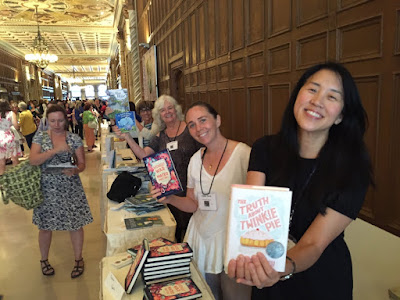 |
| r to l: Kat Yeh, Robin Yardi, Ann Whitford Paul, and Dianne White |
 |
| l to r: Anna Shinoda, Linda Joy Singleton, Sharon Skinner, and David Case (writing as Jax Spenser) |
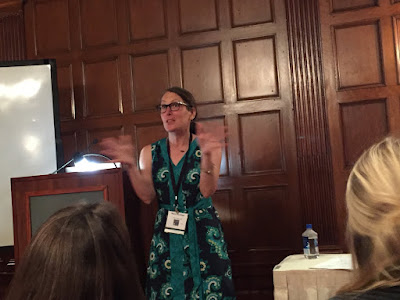 |
| Molly B. Burnham |
Molly B. Burnham is the author of the Teddy Mars series and this year’s winner of the Sid Fleishman Humor Award. At one time she studied theater but gave it up to write. She holds a Masters in Elementary Ed., and an MFA in Writing for Children and Young Adults. She has taught emotionally challenged high school students, as well as kindergartners and third graders. Before that she walked dogs, scooped ice cream, and worked at a number of record stores and bookstores. At various times during the day, she can be found eating pie at The Florence Pie Bar, which is just around the corner from where she lives. Visit: www.mollybburnham.com
Molly's session is jam packed with info, exercises, and attendees. Some highlights:
"writing is a joy, and a privilege"
Humor must be grounded in your character; their voice, actions, experience and P.O.V. all have to have a veil of humor to them.
She reviews the academic side of humor (there are three main themes: relief, superiority and incongruity) and walks us through some examples, including how in her
Teddy Mars: Almost a World Record Breaker, at one point the kids try to break the world record of breaking walnuts upon against their own heads. The idea is funny, but if the kid gets a concussion while trying this, it's not funny.
If a character only sees the sad and miserable side of everything, it's not funny.
She talks about POWER, and how if your character is powerless, it's not funny.
Molly covers additional elements of writing humor (including enthusiasm, opinions, and following the logic of scene.) She also walks us through some of her favorite exercises for writing comedy.
An excellent session!
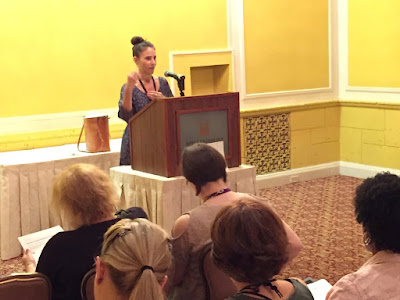 |
| Krista Marino |
Krista Marino is an Executive Editor at Delacorte Press (Random House Children's Books) where she acquires and edits young adult and middle grade fiction. Some of the books on her list include the Maze Runner series by James Dashner, the Reckoners series by Brandon Sanderson, and the Nightmares! series by Jason Segel and Kirsten Miller. Other books she’s published include The Mark of the Dragonfly by Jaleigh Johnson, These Shallow Graves by Jennifer Donnelly, The Darkest Corners by Kara Thomas, and the young adult works of Matt de la Peña. Krista is always looking for strong new voices, innovative concepts, and great stories for her list. @KristaMarino on Twitter.
Along with a robust handout and an overflow crowd (they had to bring in extra rows of chairs), Krista's session is packed with information and tips. She talks about timelines (what to do before publication and after), the importance of agents, and how being published early isn't always what's best for your book.
Some highlights...
On blurbs:
you want it on the galley or ARC, and the best way to get one is author to author.
On social media:
"the biggest part right now of putting yourself ahead of the pack."
She also shared three authors who do twitter really well: Nicola Yoon, Melissa Grey, and James Dashner.
On school visits:
And how she's seen them play such an important role in careers, like for Matt de la Pena, Chris Gravenstein and James Dashner.
And there's so much more shared in this invaluable breakout session!
Pam Muñoz Ryan is the author of New York Times best-seller ECHO, a 2016 Newbery Honor book and winner of the Kirkus Prize. She has written over 40 books for young readers.
Pam approaches writing with the idea that the story already exists and that it's her job to find it.
Pam shares many ideas on getting unstuck:
Consider approaching your writing in a new way. Try writing something outside your comfort zone (poetry, screenplay, etc.) to push your limits and boundaries. You might find that it seeps into your stories, giving it some freshness.
Consider going on writing retreats. Get away and it might help you see things differently.
Things that help Pam when writing in her office:
Playing games with herself, like writing until the dryer goes off.
Pam likes to have music playing. It helps to keep her in the zone.
Pam uses a daruma doll (also referred to as a goal doll) for each of her projects to encourage her to finish.
Pam has friends who like to work out of the office occasionally. That doesn't work for her, but it might for you.
If you can't see your characters in your mind or imagine them, consider going online to find them. Google to find an image that might represent your character and help you see him or her better.
If you ever get stuck, write from another POV or character. It's a useful exercise.

In ECHO Pam created an original fairy tale for the story. A fairy tale is all telling, not showing. This was hard for her because it felt like she was writing against all she had learned. Pam recommends using it as an exercise: write your story as a fairy tale synopsis. It might help you create a format for your story.
Be careful about using
never and
always and
can't when you think of your writing and process. Those words can become self-fulfilling prophecies.
Silence welcomes ideas.
Write with wild abandon. Release, not control.
If you get stuck, write small, not big.
Know that all writers get trapped or stuck.
Stop thinking and start feeling. The mechanics of it can get in your way.
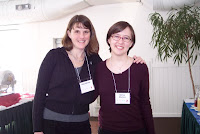 |
| Kate Messner (L) and Melissa Manlove (R) |
Melissa Manlove is an editor at the legendary Chronicle Books in San Francisco. She acquires nonfiction for all age groups, and fiction for ages 0-8—mostly visual books.
Often nonfiction writers want to portray a clear view of the world with logic. The problem is that human beings respond to the world with their emotions.
Good nonfiction speaks to the heart and to the head.
We need to learn to jump from fact to feeling. As soon as your gut recognizes something that's important, the brain remembers it. "As humans we are very different from each other in the facts of our lives. But we are alike in our feelings."
"Narrative arc is about the journey from one state to another. It is about transformation." Sometimes it's about the character, and sometimes it's about the narrator who's transformed by information.
She gave us a few examples of how this works in books.
"Fear comes from knowing something terrible is happening but not seeing all of it," she said. That's dread—so that's how you'd make something scary. (See Katherine Roy's NEIGHBORHOOD SHARKS for a glorious example of moving from fear to wonder.)
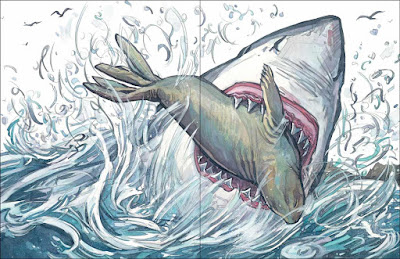
Don Brown's DROWNED CITY, about New Orleans, takes us from dread to frustration to resolve.
JOSEPHINE by Patricia Hruby Powell and Christian Robinson, takes us on Josephine's transformation from fear and anger to hope and pride and triumph. There is a universality in her reaction as well as a uniqueness.
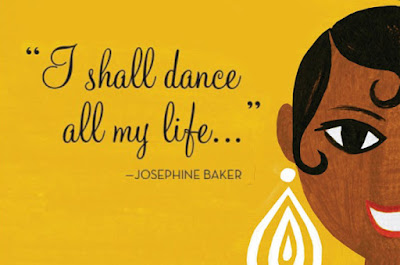
OVER AND UNDER THE SNOW by Kate Messner and Chris Silas Neal explores the isolation of being on top of snow and builds connection to creatures keeping safe in pockets beneath it.

Nonfiction helps us understand ourselves and the world around us—and can change the world. "Humans are good at thinking," she said. "The thing we're even better at is caring."
Jenni Holm is here today to tell us that currently, children's graphic novel/comics publishing is a veritable Wild Wild West, the processes of acquisition and production are different for all publishing houses, but the ones that ARE making kids comics are behind them whole hog, which is great to hear!
She recommends you read the Comics Making Bible, aka
Understanding Comics by Scott McCloud. (I'd add the New Testaments of Comics Making are Jessica Abel and Matt Madden's
Drawing Words & Writing Pictures plus the follow up,
Mastering Comics.)
She briefly tells us how comics
were written, and shows us how the actual script pages compare: the old standard Stan Lee Method, the exhaustive/OCD Alan Moore method, and the classic, screenwriting style of script like a Joss Whedon would use. Jenni recommends using a screenplay format or her storyboard format as mentioned below, but probably NOT the Marvel Comic or Alan Moore format, which most traditional children's book editors might not be familiar with.
All do in some way separate out visually in the script the dialogue vs. action vs. narration. How do you use each part in your graphic novel script?
Dialogue: Same as prose, only now in speech bubbles!
Narration: More complicated, primarily used for scene transitions, major backgroun set-up, or increasingly internal monologue, occasionally even as a character, like the snarky narrator in BABYMOUSE.
Action: Stage directions/everything else that happens.
Jenni shares with us the various ways you rough out a comic, different types of storyboards, some of which are artist driven (sketches are fairly fleshed out and laid out and basic composition is done), some that are author driven.
HOW A BABYMOUSE GETS MADE:Jenni and Matt's graphic novels always start with story first. Jenni and Matt come up with a log line, and then Jenni starts planning the story with this sort of storyboard:
Jenni already knows that the final published BABYMOUSE is going to be 96 pages, which equals about 56 pages of this storyboard.
After Jenni writes it all out, it goes to Matt, and then the editor, and when everybody loves it, it goes back to Matt for thumbnailing.
Those thumbnails get laid out page by page and are then sent to the art director who double checks it for clarity and printing guidelines.
After that it goes back to Matt to do the final art and color spotting!
TADA!Jenni lists the children's publishers doing kid's comics today:
GRAPHIX (probably biggest commercial titles publisher via Scholastic)
First Second (all ages/arty)
Random House (younger/elementary school)
ABRAMS (Nathan Hale and Cece Bell, Wimpy Kid)
TOON BOOKS (via Candlewick, super young end of spectrum)
DC and MARVEL (may want to start YA)
BOOM STUDIOS (Lumberjanes)
 |
| Matt Ringer rocking theBabysitters Club hat. |
Matt Ringler is an Executive Editor at Scholastic, specializing in chapter books, middle grade, and YA fiction.
Benefits of series;
- With series, you know what you're going to get out of it. Often this helps to keep kids reading.
- Any new book in a series sells the books that came before it.
- There's also a physical element in the bookstore. A series takes up more space, each book helping the other be recognized/noticed.
With series you have to stick with what works while it's working, but also be adaptable when that stops.
 The Puppy Place
The Puppy Place series has almost reached 50 books. Ellen Miles has figured out a format that works. Each book is basically a stand alone, but it will be familiar to the reader each time. This consistency is important for young readers. In each
Puppy Place book, a puppy will have an issue, go to a foster family, by the end someone adopts the dog, and it all feels good .
These books don't win awards but they teach kids to read.
Sometimes a book finds a great deal of success but wasn't intended to be series, but then is asked to be one. This can be challenging.
There are many ways to do a series. It's about finding something that works.
There's nothing that doesn't have series potential for Matt. Another editor who primarily works with stand alone books may not look at a book's series potential in the same way.
 Neal Shusterman won both the National Book Award and Golden Kite for CHALLENGER DEEP, his novel about mental illness.
Neal Shusterman won both the National Book Award and Golden Kite for CHALLENGER DEEP, his novel about mental illness.
"What I know about world building doesn't come from books, unless you count the books I've written. I was a bad world-builder when I first started."
World building is the hardest thing we can do as writers. We sometimes learn this the hard way. He's come up with 10 rules of world building (a few of which we'll share here).
- There are no rules except for the ones you make.
- Be prepared to live by the rules you make.
- Logic, logic, logic. Story must follow logic and characters must act accordingly.
When you're writing realistic fiction, you get to play god. When you're creating worlds, you're not just playing god, you're being god. There is increased responsibility. With world building, everything is up for grabs (including gravity).
You have to live by the rules that you've created.
You can't just throw something out there and not follow through the ramifications of that. So, if everyone disappears, that means planes that were in the air crash. How does that affect your story?
For example, what are five real-world implications of reading other people's minds?
- You'd automatically know guilt or innocence
- Everyone's head would be filled with noise
- Romantic relationships would go upside down
- We'd all know who you're really voting for
- There would be no surprise
OK. What are two ramifications of knowing people's guilt or innocence?
- There is no need for a justice system.
- You'd change who you spent time with.
So, you go through implications and their ramifications, and this is how you create a world bit by bit. Start with the simplest thing and look at all of the ramifications. Keep building on those ramifications and you will end up with a world that is extremely believable.
"We need to approach the world from the inside out."
When you create the world, the world becomes a character and you have to deal with that. When you're building a universe, the smallest changes have big effects. You have to be careful with that.
 |
| Sophie at the Gates Foundation with her artwork for the Measles and Rubella Initiative because she's so effing amazing. http://measlesrubellainitiative.org/sophie-blackall/ |
While there is nothing like hearing
Sophie Blackall speak in person — and seeing the treasure trove of images that make up her slideshows — you can get a bit of a taste of this morning's speech by reading her Caldecott acceptance speech so kindly available online at
The Horn Book.
Sophie also shares some photos of the installation of her collections she put together for Brooklyn Public Library, an installation that is as wild and fascinating as anything you'd find at the Natural Museum of History (both Sophie's installation and the American Museum of Natural History have penguins, but
Sophie's wears a top hat).
REALLY, if you're not here today to hear Sophie, the best thing you can do is go buy all of Sophie's thirty or so books, immediately.And also read her excellent blog, which tells in depth the making-of stories behind many of her books, including
Finding Winnie as well as posts about her time in places like
Rwanda or the DRC, where she was lucky enough to meet amazing kids and families.
Sophie ends with an Annie Dillard quote:
One of the things I know about writing is this: spend it all, shoot it, play it, lose it, all, right away, every time. Do not hoard what seems good for a later place in the book or for another book; give it, give it all, give it now. The impulse to save something good for a better place later is the signal to spend it now. Something more will arise for later, something better. These things fill from behind, from beneath, like well water. Similarly, the impulse to keep to yourself what you have learned is not only shameful, it is destructive. Anything you do not give freely and abundantly becomes lost to you. You open your safe and find ashes.
This year the portfolio showcase award winner its Oge Mora, who is the first-ever Student Illustrator Scholarship winner as well. That's a first for the SCBWI. She wins a trip to NYC and meetings with art directors there.
Honors went to these talented artists.
Andy Musser:
Amy Hevron
Allison Farrell
The SCBWI also awarded mentorships to Susie Ghahremani, Katie Carberry, Shahrzad Maydani, Sansu Joh, Liz Wong and Alison Farrell. The award is meant to help promising artists achieve a new level of success.
 Erica Rand Silverman is an agent at Stimola Literary Studio primarily interested in books for and about children. Prior to being an agent she was a high school teacher, working with at-risk kids. Stimola Literary is a small, boutique agency with a passionate team and a family feel. They are very selective, representing picture books through young adult.
Erica Rand Silverman is an agent at Stimola Literary Studio primarily interested in books for and about children. Prior to being an agent she was a high school teacher, working with at-risk kids. Stimola Literary is a small, boutique agency with a passionate team and a family feel. They are very selective, representing picture books through young adult.
How you decide to take on a new client:
Erica is very picky about what's she's looking for. She wants to work with clients who have a true sense of purpose in their work. She wants to fall in love with their work, and to connect with the people she chooses to work with. Erica wants to clients who know who they are trying to reach, what they are trying to say, and why.
What is it in a query that makes you want to see the work?
Be professional. Don't send out blanket queries. Erica appreciates it when people are personal in their queries, and coming to her for a reason. People can focus too much on the query, but it really all comes down to the work. Erica has to love it.
How editorial are you?
Erica loves the process of talking to an author about something that's not working and figuring out together. There's magic in that.
How would you characterize the climate for sales?
It's great to see independent book stores coming back to life. It's wonderful to see small, independent publishers being recognized for their work.
Anything we should know about?
The Common Core has created a need for more informational books. It's creating more narrative nonfiction and the mash-up between nonfiction and fiction. It's all new, causing bookstores, etc. are trying to figure out where they fit and where to shelve them.
What is one common question that you hear from people and what's the answer to it?
Are you accepting queries?
Yes.
Have you read my query yet?
Since Erica is new to Stimola Literary, she has a lot of queries. She will read all of them. If she hasn't gotten to it yet, she will.

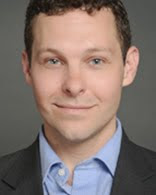 Brooks Sherman is an agent at the Bent Agency. He took a more roundabout path to publishing. He studied theater, went to work for a talent agency, and then joined the Peace Corps after being a Hollywood agent.
Brooks Sherman is an agent at the Bent Agency. He took a more roundabout path to publishing. He studied theater, went to work for a talent agency, and then joined the Peace Corps after being a Hollywood agent.
There are nine agents at his agency, and he represents authors and illustrators picture books, and middle grade, and YA (and would love to do adult books as well). He remains a theater geek, and the new Netflix show "Stranger Things" is the sort of thing that lights him up and reminds him of his childhood.
"I have the arrogance of assuming that if I love something, other people are going to love it too." He does make a distinction between loving a project and recognizing its excellence—and realizing it's not for him. For example, he was completely unimpressed with Twilight when it came out, and everyone was walking about it. "It was a nice ego check. Just because I don't like something doesn't mean it doesn't have cultural relevance."
If he does get something and loves it, he has to try selling it.
The first thing he looks for is voice. It's not just about liking the story, it's about liking how the story is told, because he's going to spend a lot of time with those characters.
He wants to represent careers, and likes to know what other ideas potential clients have in mind. He also wants to make sure potential clients agree with his notes and can have a conversation about these things. Shared vision is important. "I don't want to impose my own [vision] over it."
In a query, Brooks likes to get a sense of you, your idea, your professional demeanor, and your writing chops. "Based on those things, I'm going to look at your pages and see if I connect to the voice."
The marketplace is crowded and competitive, so he is editorial with his clients. "A project has to be that close to perfect before an editor is going to get the go-ahead from the rest of their team to acquire it." He also loves that blend of creative professional.
That agents are more editorial doesn't mean you should send work you haven't made as good as you can get it. "At every step in the way, you think it's perfect, and the next person in the process takes it that much further."
Fabulous
Tina Wexler of ICM Partners tells us a little bit of her Super Agent Origin Story. ICM is one of the oldest agencies around with offices all over the place, Tina works at the NY office. She started there as an assistant 13 years ago and loves the brain trust that is her extended family of agents and staff.
Her list is mostly MG and YA, she's not really looking for picture books. She's excited for nonfiction YA essay collections and she also wants to represent diverse books.
TINA IS A CAT PERSON. She says that's probably all we need to know.
Lin asks what does a manuscript need for Tina to acquire it?
Tina says it's two parts, and very simple: Do I love it? Can I sell it?
As she's reading it and falling in love, can Tina start to think of names of editors she can sell it to? If she can't think of those names, Tina will pass on it in the hopes it is picked up by another great agent who can polish/position it in the way the manuscript needs to be to get that great sale and success.
Lin asks if Tina is an editorial agent: Tina agrees with the majority of the panel that she does (and most agents today do) tend to edit an acquired manuscript to be its very best before it goes out to editors (who will then revise even more). But Tina wants to point out that the author MUST first revise enough on their own until they are sure what they are submitting to an agent is at its absolute best. Don't be sending your work out in the hopes an agent will edit it into shape, you do that on your own.
Something Tina says we need to take much more seriously than we do are our buying practices:
SUPPORT INDEPENDENT BOOKSTORES! SUPPORT LIBRARIES!
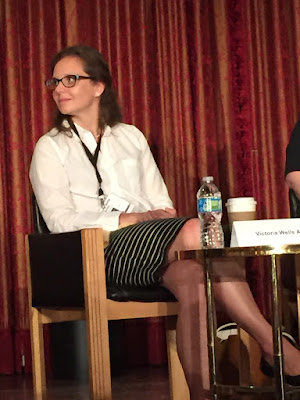 |
| Agent Victoria Wells Arms |
Victoria Wells Arms started as an editor at Dial Books for Young Readers, and then Putnam. One day, she spotted an ad for an editorial director at Bloomsbury and was chosen to set up Bloomsbury USA’s children’s division. Starting with three people (and a dog), Bloomsbury grew quickly, soon hitting the bestseller lists and acquiring major awards. In 2013, Victoria opened her own agency, Wells Arms Literary, where she represents authors and illustrators for the full range of children’s books, from board books to young adult, as well as some nonfiction. Visit: www.wellsarms.com and follow her on Twitter: @VWArms and @WALiteraryVictoria shares that in addition to being sure that asking "do I love it?" and "can I sell it?" that she wants to know who a potential client is as a human being. She says
"I want to know there's depth to what you're doing, and that you're in it for the long hall."
explaining that she doesn't represent single project, but people, for their careers.
She adds, "It feels like every one of my clients is a friend" and she wants to sign someone she wants to be friends with. No divas or those wrapped up in their egos.
Victoria says that she is an editorial agent, "I always work with them [her clients] on making it better." If she can help her clients make it better, it's that much easier for editors to take it on.
"I think it's a great time. It IS really competitive. ...But I think editors are wanting to find interesting books."
Victoria reps artists and writers.
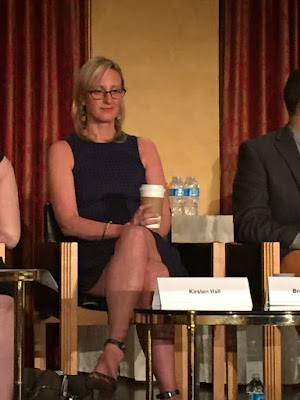 |
| Agent Kirsten Hall |
Kirsten Hall is President of Catbird, a boutique children’s literary and illustration agency. She has brokered many hundreds of children’s book deals between authors, illustrators, and all of the major American publishers. She is also the author of many books for kids. Her first trade picture book, The Jacket, was a 2014 New York Times Notable). Kirsten opened Catbird's wings in March 2014, and she likens her agency to a creative playground. Her focus is debut talent, and she works intimately with her clients to create and develop original story pitches—especially picture books. According to Publishers Marketplace, Kirsten reported more new picture book deals in 2015 than any other agent. Visit: www.catbirdagency.comKirsten tells us about how she specializes in picture books.
"I can look at something and very quickly know… if it speaks to me."
She keeps it small, curated, and everyone on her team does something different.
As to queries, Kirsten loves jokes and personal and human and hates standard query letters.
How editorial is Kirsten? "I'm not." If I see something, and that there's something completely golden about it, "I present them (editors) with something they should do their job on."
Kirsten also spoke about the new hybrid titles that are merging fiction and nonfiction, called "informational" books.
"Publishing, at least in picture book land…I feel like everyone's upping their game." There's so much out there already that's good, so we authors and illustrators have to mine what's unique about what we're offering.
"That's the only way your light's going to shine in this pretty bright room."
Kirsten reps artists and writers.
"I'm really heart-based. I rely on my instincts, I think they're sharp."
.jpeg?picon=2287)
By: Lee Wind, M.Ed.,
on 7/31/2016
Blog:
The Official SCBWI 10th Annual New York Conference Blog
(
Login to Add to MyJacketFlap)
JacketFlap tags:
#LA16SCBWI,
Erica Rand Silverman,
Victoria Wells Arms,
agents,
Lin Oliver,
Tina Wexler,
Ginger Clark,
agent panel,
Kirsten Hall,
Brooks Sherman,
Add a tag
Moderated by Lin Oliver (standing, far left), the agent panelists are, left to right: Victoria Wells Arms (Victoria Wells Arms Agency), Ginger Clark (Curtis Brown, Ltd.), Kirsten Hall (her own agency, Catbird), Brooks Sherman (The Bent Agency), Erica Ran Silverman (Stimola Literary Studio), and Tina Wexler (ICM Partners.)
.jpeg?picon=2287)
By: Lee Wind, M.Ed.,
on 7/30/2016
Blog:
The Official SCBWI 10th Annual New York Conference Blog
(
Login to Add to MyJacketFlap)
JacketFlap tags:
#LA16SCBWI,
Erica Rand Silverman,
Tina Wexler,
Krista Marino,
Stacey Barney,
Ginger Clark,
Reka Simonsen,
Neal Porter,
Melissa Manlove,
Sara Sargent,
Kirsten Hall,
Kat Brzozowski,
Brooks Sherman,
Add a tag
A new opportunity at the SCBWI Summer Conference, these informal conversations with faculty members including agents and artist reps (Ginger Clark, Erica Rand Silverman, Tina Wexler, Kirsten Hall and Brooks Sherman) and editors and publishers (Krista Marino, Neal Porter, Sara Sargent, Melissa Manlove, Stacey Barney, Kat Brzozowski, and Reka Simonsen) are a big hit!
 |
| Attendees with agent Ginger Clark |
 |
| Attendees with Publisher Neal Porter |
John Parra is asked what he thinks makes a good picture book:
"When I feel like I get to a magical sweet spot in the [sketch] work that I can translate into the [final art] work... when I can feel like something magical is happening... that's what I'm looking for personally and professionally, even before an audience sees it.
Not everything you do will work or be interpreted by an audience they way you wished it would, but when you do get positive responses, you know it's good."
Susan Rich is asked the same question, and she says she asks herself three questions (which she says are stolen from The Horn Book) when reading the picture book:
"The picture book presents a
what if..."
A
then what that follows well from that
what if...
And then you can step back and say
so what.""We expect picture books to be read a gazillion times, it has to stand up to weary parents and antsy toddlers over and over..."
Susan also addresses what makes a commercially successful book to her:
"... I hope they are paving the way for me to publish more books by those creators, I'm looking for sales and critical acclaim, that it connects with some demographic in an important way and that we can build on that with more books from those creators.
Curricular or seasonal hooks can make your books easier to
get BUT I would never recommend starting from there. You can think about that at the query or later at the marketing level."
John says to follow your own voice, and don't worry about commercial vs. personal work, make it personal. Make it unique to your voice, and that's what's going to define you in your career. Be the first-rate you and not a third-rate Jon Klassen.
Susan says the best picture book texts have room for an illustrator to bring it to life, but also are manuscripts meaty enough to provide pacing and carry through with a full, narrative story, which is why poetry is not always a natural fit for picture books even if it's a completely beautiful and lyrical poem.
Laurent asks them about books they loved as kids:
John mentions
Virginia Lee Burton's LIFE STORY.
Susan Rich loved
C D B! by William Steig (link only goes to the colorized version :( )
The first half of always awesome Lauren Rille of Simon & Schuster's afternoon session went over Bigger Picture Stuff for getting your picture book sketches and layout in good, overall shape before you move on to final art. But here are a few Smaller Picture Stuff details from the second half of her talk:
Once global pacing, tone, palette, etc., are established in your story art,
then you can go through and focus on all of those big picture things again, but page by page.
Simon's New Bed by
Christian Trimmer and illustrated by
Melissa van der Paardt has a fantastic example of how you can push POV/perspective in just one spread to completely change the entire emotional tone of the story:
Lauren shares the initial sketch of the scene where dog Simon comes into the room ready to use his new dog bed for the first time... And cat Miss Adora Belle...
The editorial team likes this sketch very much, but they ask Melissa to push the drawing even farther, to visually interrupt what had been a light and breezy, happy day of anticipation for Simon in these two earlier spreads:
And "stop the music" as Lauren says in the spread in question. And Melissa comes back with this:
Environment is the same, characters are the same, but look at all you can achieve with just a shift in camera angle!
And even with the POV change, the editorial team wants things to go one step further. Since this scene is the big shifting moment in the story's emotional arc so far, changing up the lighting and palette compared to the earlier spread will help underscore the change in the story's tone even more.
So good!
Thanks to Lauren and S&S for letting us use these images from her actual slides!
Jessixa Bagley and Don Tate took part in our panel on picture books. Jessixa is the Golden Kite winner for picture book texts, and Don has won numerous awards for his critically acclaimed texts and illustrations.
What makes a picture book successful? There's a sense of completion to it,
Jessixa said. It doesn't assume that the reader has knowledge about the subject. There's nothing left hanging. It's like an amuse bouche, a perfect bite. She's also drawn to books with a really deep meaning—a meaning that can be joyful too.
Don loves it when people can flip through his book and know the story by the pictures. He loves making emotional connection with readers. We connect with our readers through emotions. Page turns help guide readers from left to right through the story. "I like it when the illustrator has really done their job ... and you want to linger and live in that space for a while."
When it comes to developing stories for markets Don doesn't illustrate books differently on whether they're commercial or more for libraries. Don loves to illustrate books about little-known historical figures, which typically puts his books into the school/library market. This lets him do more school visits.
Jessixa also doesn't think about making books directly for markets, and thinks that books with emotional content can be really useful in school markets.
What collaborations help? Don is in several critique groups. They help him make his manuscripts stronger for agents.
Jessixa says you should treat your work like a baby egg. Nurture it until it gets a little more solid, and then you can share it. You won't be as hurt by the feedback. It won't be as bruising. It will be able to hatch. "We've all had the experience where you work on something really hard and you show it to someone and they don't respond to it, and you're gutted."
Advice: Don: Be sure to keep your stories child-focused. It's important to engage a child by beginning in childhood. Children like to see themselves represented on the first page of a book. He's not a fan of labeling books by gender. Sometimes, books appeal more to boy than to girls. But you don't need to labels. "Let the readers find them where they will."
Jessixa wasn't a girly girl. She wasn't a tomboy. She was just herself, so she gravitated toward identity-neutral things. There is universality to her work that she wants to extend. "I have a hard time with the fact that there are pink LEGOs and those are the girl LEGOs."
"Allowing the space to have things appeal to more people, whether it's gender or diversity, is going to make us all a lot stronger."
.jpeg?picon=2287)
By: Lee Wind, M.Ed.,
on 7/30/2016
Blog:
The Official SCBWI 10th Annual New York Conference Blog
(
Login to Add to MyJacketFlap)
JacketFlap tags:
#LA16SCBWI,
picture books,
Don Tate,
john parra,
Laurent Linn,
Barney Saltzberg,
Susan Rich,
jessixa bagley,
Add a tag
Moderated by Laurent Linn (standing), the panelists, left to right, are: author/illustrator Jessixa Bagley, illustrator John Parra, editor Susan Rich, author/illustrator Barney Saltzberg, and author/illustrator Don Tate.
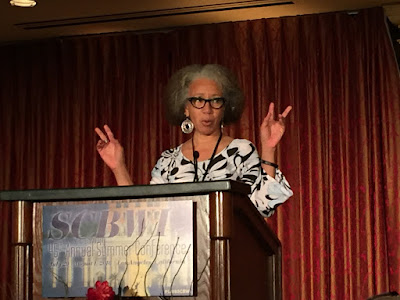 |
| Carole Boston Weatherford giving her keynote |
Carole Boston Weatherford is an award-winning, New York Times best-selling author of over forty books, mostly for young people. Her books have won two NAACP Image Awards, two Caldecott Honors, and a Coretta Scott King Award. Her best-known titles include Moses: When Harriet Tubman Led Her People to Freedom; Voice of Freedom: Fannie Lou Hamer, Spirit of the Civil Rights Movement; Freedom on the Menu: The Greensboro Sit-ins; and Gordon Parks: How the Photographer Captured Black and White America. Her latest release is You Can Fly: The Tuskegee Airmen, a collaboration with her son, debut illustrator Jeffery Weatherford. She is an English professor at Fayetteville State University in North Carolina. Visit https://cbweatherford.com.
Lin's introduction includes calling Carole "a national treasure… She's an historian, she's a story-teller."
Carole jumped right in to share that:
"The premise may be the most important 25 words you write."
Whether you call it an elevator pitch, log line, or T.V. guide pitch, the aim is the same - to distill your storyline to one easily understood sentence that conveys what the protagonist has to overcome. The premise is a promise your manuscript will deliver on.
Brief. Provokative. Contains character, conflict, and a hook that you and your readers can be passionate about, and reveals something about the larger world.
She shared premises of different children's books (picture books through YA, fiction and nonfiction) to see if we, the audience, can guess the book - showing us what good premises accomplish.
Carole then told us about the organic way she came up with the premises for some of her books, how those premises shifted and developed and coalesced. Books she spoke about included:
Freedom on the MenuA Negro League ScrapbookAnd
MosesWe heard poems, and stories, and as Carole's whole talk proved,
"There is power in knowing your premise."
View Next 21 Posts
 Deborah Halverson is the award-winning author of Writing New Adult Fiction and Writing Young Adult Fiction for Dummies as well as teen novels Big Mouth and Honk if You Hate Me, the picture book Letters to Santa, and three books in the Remix series for struggling readers. Formerly an editor at Harcourt Children's Books and now a freelancer specializing in Young Adult/Middle Grade fiction.
Deborah Halverson is the award-winning author of Writing New Adult Fiction and Writing Young Adult Fiction for Dummies as well as teen novels Big Mouth and Honk if You Hate Me, the picture book Letters to Santa, and three books in the Remix series for struggling readers. Formerly an editor at Harcourt Children's Books and now a freelancer specializing in Young Adult/Middle Grade fiction.
 In ECHO Pam created an original fairy tale for the story. A fairy tale is all telling, not showing. This was hard for her because it felt like she was writing against all she had learned. Pam recommends using it as an exercise: write your story as a fairy tale synopsis. It might help you create a format for your story.
In ECHO Pam created an original fairy tale for the story. A fairy tale is all telling, not showing. This was hard for her because it felt like she was writing against all she had learned. Pam recommends using it as an exercise: write your story as a fairy tale synopsis. It might help you create a format for your story.



 The Puppy Place series has almost reached 50 books. Ellen Miles has figured out a format that works. Each book is basically a stand alone, but it will be familiar to the reader each time. This consistency is important for young readers. In each Puppy Place book, a puppy will have an issue, go to a foster family, by the end someone adopts the dog, and it all feels good .
The Puppy Place series has almost reached 50 books. Ellen Miles has figured out a format that works. Each book is basically a stand alone, but it will be familiar to the reader each time. This consistency is important for young readers. In each Puppy Place book, a puppy will have an issue, go to a foster family, by the end someone adopts the dog, and it all feels good . Neal Shusterman won both the National Book Award and Golden Kite for CHALLENGER DEEP, his novel about mental illness.
Neal Shusterman won both the National Book Award and Golden Kite for CHALLENGER DEEP, his novel about mental illness.
 Erica Rand Silverman is an agent at Stimola Literary Studio primarily interested in books for and about children. Prior to being an agent she was a high school teacher, working with at-risk kids. Stimola Literary is a small, boutique agency with a passionate team and a family feel. They are very selective, representing picture books through young adult.
Erica Rand Silverman is an agent at Stimola Literary Studio primarily interested in books for and about children. Prior to being an agent she was a high school teacher, working with at-risk kids. Stimola Literary is a small, boutique agency with a passionate team and a family feel. They are very selective, representing picture books through young adult. Brooks Sherman is an agent at the Bent Agency. He took a more roundabout path to publishing. He studied theater, went to work for a talent agency, and then joined the Peace Corps after being a Hollywood agent.
Brooks Sherman is an agent at the Bent Agency. He took a more roundabout path to publishing. He studied theater, went to work for a talent agency, and then joined the Peace Corps after being a Hollywood agent.


